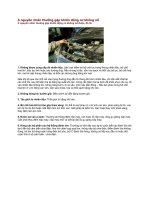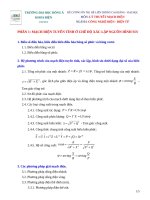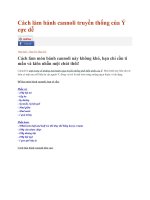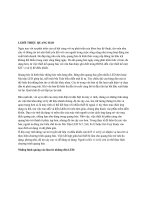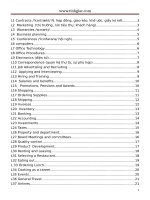www.tinhgiac.com Allegro Constraint Manager User Guide ECSets and Topology Templates
Bạn đang xem bản rút gọn của tài liệu. Xem và tải ngay bản đầy đủ của tài liệu tại đây (133.51 KB, 9 trang )
Allegro® Constraint Manager User Guide
4
ECSets and Topology Templates
Topics in this chapter include
"What is a Topology Template?"
"Importing ECSets"
"Mapping Templates and ECSets to Net-related Objects"
"Audits"
"Exporting ECSets"
"Migrating Legacy Electrical Rule Sets"
What is a Topology Template?
A topology template file (.top) is an on-disk image of the SigXplorer database. A topology
template file contains the same data as an ECSet, including electrical constraints, but it also
contains information to support the graphical representation of a circuit topology in SigXplorer.
Note: Constraint Manager, when launched from an L Series PCB editor, does not support
topology exploration. If you are using an L Series PCB editor, you can ignore the descriptions
of the following commands in this chapter:
File - Import Electrical CSets
File - Import Analysis Results
File - Export Electrical CSets
File - Export Analysis Results
Audit - Topology Templates
In pre-14.0 designs, a topology template was applied to a group of target nets. In the process,
constraint information was extracted from the topology file and flattened; constraints were
copied to individual target nets as properties. With Constraint Manager, these properties are not
flattened; they remain intact, collectively, as an ECSet. Net-related objects in the design
reference the ECSet rather than a collection of individual properties.
The topology template can be imported to, and exported from, Constraint Manager. When
imported, the topology template information will be instantiated within Constraint Manager as
an ECSet where it can be manipulated separate from the topology template. The ECSet is saved
with the database of the host application from which Constraint Manager was
1
invoked: a board file (.brd) or a schematic view.
Figure 4-1 Topology Template/ECSet constraint flow
With such a close alignment between a topology template and an ECSet, you can access
SigXplorer directly from Constraint Manager. In fact, you can define your constraints in
SigXplorer--as a topology template--and then import this information into Constraint Manager
as an ECSet. Conversely, you can define your constraints in Constraint Manager--as an ECSet-and then export this information to SigXplorer as a topology template. See the Design
Exploration Phase (with SigXplorer) for information on the Constraint Manager-SigXplorer
design flow.
The only constraint that you cannot define in Constraint Manager is user-defined pin
scheduling. This must be defined in SigXplorer. You can, however, select from a list or predefined pin schedules in Constraint Manager.
Importing ECSets
Constraint Manager promotes design reuse through the following command:
Use this
command
File - Import Electrical CSets
To
Import a selected on-disk topology template into Constraint Manager. The
imported template will become an ECSet which can be referenced by netrelated objects that share the same electrical characteristics. See "Mapping
Templates and ECSets to Net-related Objects" .
If the imported template was previously assigned as an ECset, the import
will overwrite existing constraint values.
Note: If the Automatic Topology Update checkbox is enabled (Tools Options Figure 4-2 ), the refreshed template information is immediately
applied to the net-related objects; otherwise, you must choose Tools Update Topology to apply the changes.
Mapping Templates and ECSets to Net-related Objects
Constraint Manager intelligently maps the constraint information, imported from a topology
2
template or defined in an ECSet, to a candidate net that matches the topological characteristics
of the referenced ECSet. If the candidate net does not match these topological characteristics,
the mapping will fail and the constraints will not be applied.
In the Mapping Mode column in the All Constraints worksheet (in the ECSet folder), you can
specify a mapping mode. Constraint Manager makes several passes based on the following
mapping modes:
See the following commands in the Allegro Constraint Manager Reference for more
information:
Objects - Electrical CSet References
File - Import - Electrical CSet
All other electrical constraints will be inherited regardless of mapping since the other
constraints are not topology specific.
Choose Tools -- Options to control how objects in Constraint Manager inherit constraint
information.
Figure 4-2 Options Dialog Box with Default Settings
The following describes how to use the Electrical CSet Apply fields of the Options dialog box
(see Figure 4-2 ).
Checkbox Option
Function
Automatic topology
update
Controls how topology-related constraints are re-applied
When the design changes (component placement, signal model
updates)
(Defaults to enabled)
- or When an ECSet is initially referenced
3
When enabled, Constraint Manager applies changes on-the-fly as the
design changes.
When disabled, you can apply changes by choosing
Tools -- Update Topology.
If you change state from disabled to enabled, Constraint Manager
presents you with a confirming message stating that it will refresh stale
nets and Xnets with updated topology data.
Disabling automatic topology update may be
necessary when design changes are frequent
and complex ECSets are referenced.
Overwrite existing
constraints
(Defaults to disabled)
Controls whether constraint values in the ECSet will overwrite any
existing net-related constraints when an ECSet is re-applied. See
"Methods of Constraining Nets" for information about overriding
inherited constraint values.
Enabling overwrite existing constraints is
necessary when migrating pre-14.0 designs
using the Audit - Topology Properties
command. This will ensure that all net-related
overrides-- created by the pre-14.0 topology
template mapping software--are removed.
Rip up etch when mapping Controls whether etch (clines and vias) is removed when an ECSet is
topology
re-applied and the schedule of the net changes.
(Defaults to disabled)
Audits
Constraint Manager provides audits to give you feedback, in report form, about the constraints
and their references in the design. Audit commands are available when Constraint Manager is
invoked from a PCB- or design entry-editor, or APD. The following audits (accessible from the
Audit menu) relate to ECSets.
Run this audit
To
Constraints
List net-related overrides and constraint violations.
Obsolete Objects
List objects that should, but no longer exist in
in the board or schematic database, yet they are still being referenced
in Constraint Manager.
4
Electrical CSets
List the mapping status of all objects which reference ECSets.
Note: Constraint Manager, when launched from a Series L editor,
does not support pin pairs. Any pin pairs that exist will appear as `not
supported' in the audit report.
Topology Properties
Migrate pre-14.0 ASSIGN_TOPOLOGY and
TOPOLOGY_TEMPLATE properties to an ECSet reference.
Note: Constraint Manager, when launched from an L Series PCB
editor, does not support topology exploration.
The sections that follow describe these audits.
Constraint Audit
The Constraints audit (Audit - Constraints) generates a report listing constraint errors. This
report aids you in troubleshooting constraint violations. The audit includes the following
checks:
Min values that exceed Max values
Values less than zero
Completeness violations
Group membership violations
Relative group violations
Paired parallelism lengths and gap
Setup and hold relative to clock period
Differential pair member mismatches
Net-related overrides
Note: A net override lets you replace the inherited value from an ECSet with a value that you
specify on a net-by-net basis. Cells with net overrides are colored blue.
Obsolete Objects Audit
The Obsolete Objects audit (Audit - Obsolete Objects) generates a report that lists objects that
must be reconciled between Constraint Manager and the PCB or schematic databases.
Constraint Manager displays a No Obsolete Objects message as appropriate.
For example, if you use Constraint Manager to constrain an object in the schematic, that
object will be stored in the schematic editor's constraint view of the HDL library. If you later
delete that object in the schematic, that constraint will still be in Constraint Manager until it
is reconciled with the obsolete objects audit.
This command is used subsequent to importing a dictionary and constraint file (File - Import Constraints) or when the connectivity is disjoint between the component or net in
schematic and the corresponding Constraint Manager object.
Note: The Audit - Obsolete Objects command is not available when running Constraint
Manager in stand-alone mode.
5
The Audit Obsolete Objects dialog box contains the following fields:
Table 4-1 Obsolete Objects Dialog Box Options
Use this field
To
Type
Filter on an object type (bus, net, Xnet)
Obsolete Objects
List all objects that no longer exist in the PCB or schematic database, yet
exist in Constraint Manager
Existing Objects
List all objects that exist in the PCB or schematic database, and in
Constraint Manager
Delete
Remove objects, listed in the obsolete objects list, from the PCB or
schematic database.
Merge
Assign all properties and constraints from the object selected in the
obsolete object list to the object selected in the existing object list
(properties and constraints on the existing object are not overwritten).
Electrical CSets Audit
The Electrical CSets audit (Audit - Electrical CSets) generates a report listing the current
ECSets in the design and the status of all net-related objects that reference them. The head of
the report summarizes the number of ECSet references and any errors.
The status reports the inheritance for each constraint defined in the ECSet including:
Any mismatch of the topological characteristics between a net-related object and the
ECSet (in which case, the constraint from the ECSet is not inherited).
The net-related object that inherits the ECSet constraint.
When the head of the Referenced Electrical CSet column is yellow, this
indicates there is a stale ECSet reference. You run the Electrical ECSet
audit to clear this setting and to resolve any discrepancies.
Topology Templates Audit
The Topology Templates audit (Audit - Topology Templates) migrates deprecated properties to
ECSet references used by Constraint Manager.
Note: Constraint Manager, when launched from an L Series PCB editor, does not support
topology templates.
In pre-14.0 designs, electrical constraints were captured using three entities: the topology
template (specified with the TOPOLOGY_TEMPLATE property), the topology assignment
(specified with the ASSIGN_TOPOLOGY property), and the constraint set (specified with the
ELECTRICAL_CONSTRAINT_SET property).
In 14.0 designs, only the ECSet association is supported; the TOPOLOGY_TEMPLATE and
the ASSIGN_TOPOLOGY properties are no longer required. All topology information is now
contained in the ECSet (specified with the ELECTRICAL_CONSTRAINT_SET property).
6
The topology templates audit removes the TOPOLOGY_TEMPLATE,
TOPOLOGY_TEMPLATE_REVISION, and ASSIGN_TOPOLOGY references from netrelated objects.
The Audit Topology Templates dialog box contains the following fields:
Table 4-2 Audit Old Template Dialog Box Options
Use this field
To
Topology template values
(drop-down menu)
List all TOPOLOGY_TEMPLATE and
ASSIGN_TOPOLOGY property values in the design.
Once a property value is selected from the drop-down menu,
all nets which have the same template value are listed.
Update to use Electrical Cset
Import (radio button)
Import a new template. The field beside the radio button
will be populated with a Topology Template (.top file) name
if one exists on disk.
The TOPOLOGY_TEMPLATE_PATH environment variable ise
used to search for a template file with the same name as the
property value
Browse
Find the appropriate template file if Constraint Manager
cannot locate it.
Existing (radio button)
Use an existing ECSet. This option will be the default if the
design contains an ECSet with the same name as the
property value
Overwrite existing constraints (check Controls whether constraint values in the ECSet overwrite
box)
any existing net-related constraints when an ECSet is reapplied.
Enabling overwrite existing
constraints is necessary when
migrating pre-14.0 designs. This
ensures that all net-related
overrides-- created by the pre-14.0
topology template mapping
software--are removed.
Apply
Migrate all listed nets to reference the imported or existing
ECSet. Once migrated, nets will have their
7
TOPOLOGY_TEMPLATE and ASSIGN_TOPOLOGY
properties deleted.
Constraint Manager displays a properties up to date
message as appropriate.
Exporting ECSets
Constraint Manager promotes design reuse through the following commands:
Use this command
To
File - Export - Electrical CSets
Save selected ECSets, from a design, or from a system, to a
topology template (.top) file on disk.
File - Export - Constraints
Export a dictionary and constraints file (.dcf) to disk. The
dictionary and constraints file contains a complete snapshot of
all electrical constraint information. This includes any userdefined properties, all ECSets and their constraints, and all
net-related objects and their constraints (including ECSet
references). The dictionary and constraints file is proprietary
to Cadence Design Systems and, as such, is not available for
editing.
You would typically save to a dictionary and constraint file
prior to making extensive constraint modifications within
Constraint Manager. The dictionary and constraints file is then
considered an archive from which you could revert back.
Exporting a dictionary and constraints file results in
overwriting constraint data saved from a previous archive.
Migrating Legacy Electrical Rule Sets
Designs created prior to release 14.0 may contain Electrical Rule Sets. As part of the process of
upreving a design to release 14.0, these Electrical Rule Sets are migrated to Constraint Manager
as Electrical Constraint Sets (ECSets).
Return to top of page
For support, see Cadence Online Support service.
Copyright © 2012, Cadence Design Systems, Inc.
All rights reserved.
8
9
